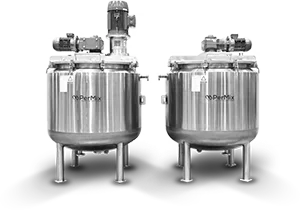Industrial Mixers
PerMix News & Updates



Shear pumps and inline homogenizers are both types of high-shear mixing equipment used to emulsify, disperse, or blend materials, especially liquids with different viscosities or immiscible phases like oil and water. While they are similar in purpose, they differ in design, performance, and best-use scenarios.
| Feature | Shear Pump | Inline Homogenizer |
|---|---|---|
| Primary Purpose | Pumping + shearing | High-intensity emulsification & particle size reduction |
| Shear Intensity | Medium to high | Very high (typically greater) |
| Rotor/Stator Design | Fewer stages, simpler geometry | Multiple stages, tighter tolerances |
| Particle Size Reduction | Down to ~20–50 microns | Down to ~1–5 microns (or lower in multi-stage units) |
| Throughput | Higher flow rates | Lower flow rates compared to shear pumps |
| Pressure Handling | Moderate | High pressure operation (some >1,500 psi) |
| Viscosity Handling | Excellent for low-to-medium viscosity fluids | Better for low viscosity or pre-mixed high viscosity |
| Typical Applications | Transferring, pre-mixing, medium emulsions | Fine emulsions, microemulsions, pharmaceutical use |
PerMix manufactures both shear pumps and inline homogenizers to suit every application. With customizable stages, pressure ratings, and seal configurations (mechanical, air-purge, or dry-run), PerMix delivers optimized performance for your specific process needs—backed by industry-leading innovation, engineering, and value.
PerMix #MixingSolutions #HighShearMixing #InlineHomogenizer #ShearPump #PharmaProcessing #CosmeticsManufacturing #FoodProcessing #IndustrialMixers #EngineeringExcellence #InnovationInMixing
